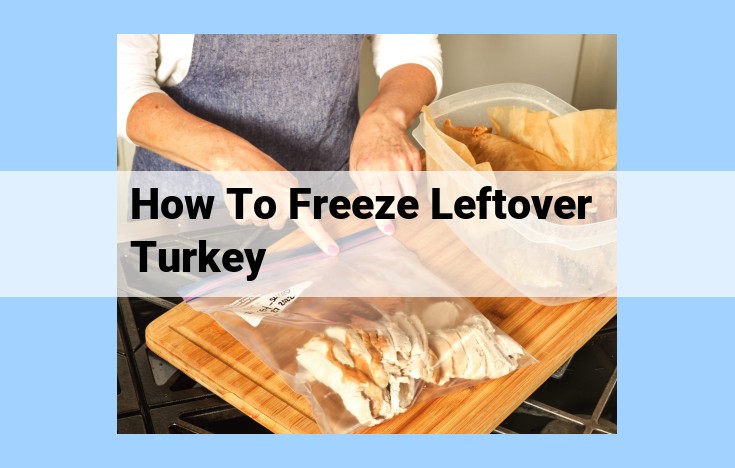Freeze Leftover Turkey Right: Tips For Food Safety And Quality

Properly freezing leftover turkey is essential for preserving its quality and safety. Freezer-safe containers, aluminum foil, or plastic wrap can be used to store turkey for up to 2-3 months. Cut the turkey into smaller pieces and divide it into portions for easier freezing and reheating. Label and date the containers to ensure freshness. Thaw the turkey in the refrigerator overnight or under cold running water before reheating it to ensure thorough cooking.
Freezing Food: Essential Components for Safe and Hassle-Free Storage
Freezing food is a convenient and effective way to preserve its quality and extend its shelf life. However, it’s crucial to adhere to food safety guidelines to ensure the safe handling and storage of frozen foods.
Food Safety Guidelines for Freezing
- Cleanliness is key: Wash your hands thoroughly before handling food and clean all surfaces that come into contact with it.
- Proper packaging: Use freezer-safe containers, aluminum foil, or plastic wrap to prevent freezer burn and contamination.
- Avoid cross-contamination: Keep raw meat and poultry separate from other foods to prevent the spread of bacteria.
- Rapid freezing: Freeze food as quickly as possible to prevent bacteria growth. Use a blast freezer or the coldest setting on your regular freezer.
- Defrost safely: Thaw frozen food in the refrigerator, microwave, or under cold running water. Avoid thawing at room temperature.
Storage Methods for Frozen Food: Preserving Quality and Safety
Ensuring the safe and efficient storage of frozen food is crucial to maintaining its quality and nutritional value. The choice of storage method plays a significant role in preventing spoilage and extending the shelf life of your frozen treasures.
Freezer-Safe Containers: The Guardians of Frozen Delights
Invest in durable and reliable freezer-safe containers that will create an airtight seal, preventing freezer burn and moisture loss. These containers come in various shapes and sizes, allowing you to optimize space and store everything from delicate sauces to bulky roasts.
Aluminum Foil: A Protective Shield for Frozen Flavors
Aluminum foil, with its malleability and heat-resistant properties, is an excellent choice for wrapping frozen foods. It shields them from light, air, and moisture, safeguarding their delicate flavors and textures.
Plastic Wrap: A Flexible Ally for Frozen Delicacies
For smaller items or awkwardly shaped foods, plastic wrap offers a flexible solution. Its clingy nature ensures a snug fit, preventing freezer burn and preserving moisture. However, it’s essential to choose freezer-grade plastic wrap to withstand the cold temperatures.
Monitoring and Tracking Frozen Food
Keeping track of your frozen food is crucial for both food safety and preserving its quality. One essential tool for this is a temperature probe, which allows you to monitor the internal temperature of your frozen items.
Why Use a Temperature Probe?
When food is frozen, bacteria growth slows down but doesn’t stop. If the temperature rises too high, bacteria can start to multiply, potentially causing spoilage or foodborne illness. Using a temperature probe ensures that your food stays within the safe temperature zone for frozen storage, below 0°F (-18°C).
How to Use a Temperature Probe
Insert the probe into the thickest part of the food, avoiding bones or fat. The probe should be inserted at least 2 inches deep. Press the “read” button on the probe and wait for the temperature to stabilize.
What Temperatures to Monitor
For frozen food, the target temperature is 0°F (-18°C) or below. If the temperature rises above 0°F, move the food to a colder part of the freezer or thaw it and refreeze it.
Tips for Monitoring and Tracking
- Regularly check temperatures: Use the temperature probe to monitor your freezer’s temperature and the internal temperature of frozen foods, especially after power outages or long periods of door opening.
- Label and date food: Place labels or write on freezer containers with the date you froze the food. This helps you keep track of how long it’s been in the freezer and when it should be used.
- Use a freezer inventory app: There are mobile apps available that allow you to scan food items and track their storage time.
By using a temperature probe and following these monitoring and tracking tips, you can ensure that your frozen food stays safe and fresh for as long as possible.
Techniques for Frozen Food: Defrosting and Reheating
Once your food is safely frozen and stored, it’s time to give it some love and bring it back to life! There are a few key techniques to master when it comes to handling frozen food:
Defrosting Methods:
-
Refrigerator Thawing: The slow and steady way to defrost. Place your frozen food in the refrigerator and allow it to thaw gradually. This method preserves the food’s quality and texture best.
-
Microwave Defrosting: A quick and convenient option. Place your frozen food in a microwave-safe container and use the defrost setting. Monitor the food closely to prevent it from cooking.
-
Cold Water Thawing: A perfect choice for meat. Place your frozen food in a sealed bag and submerge it in cold running water. Change the water every 30 minutes to speed up the process.
Reheating Methods:
-
Oven Reheating: Ideal for dishes that require even heating. Preheat your oven to the desired temperature and place your frozen food on a baking sheet. Cover it with aluminum foil to prevent drying out.
-
Stovetop Reheating: Perfect for smaller portions. Heat a skillet or pan over medium heat, add a little oil, and add your frozen food. Cover and stir occasionally until heated through.
-
Microwave Reheating: A quick and easy method, but it can overcook. Place your frozen food in a microwave-safe container, cover it, and heat on low power for short intervals, stirring in between.
Remember, never refreeze thawed food. It’s important to follow these techniques carefully to ensure the safety and quality of your delicious frozen meals.